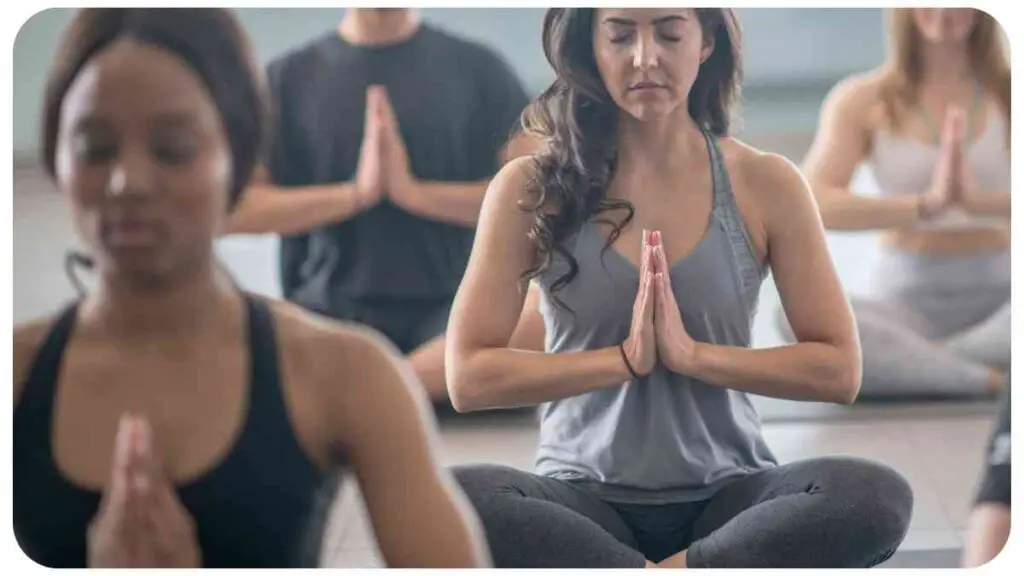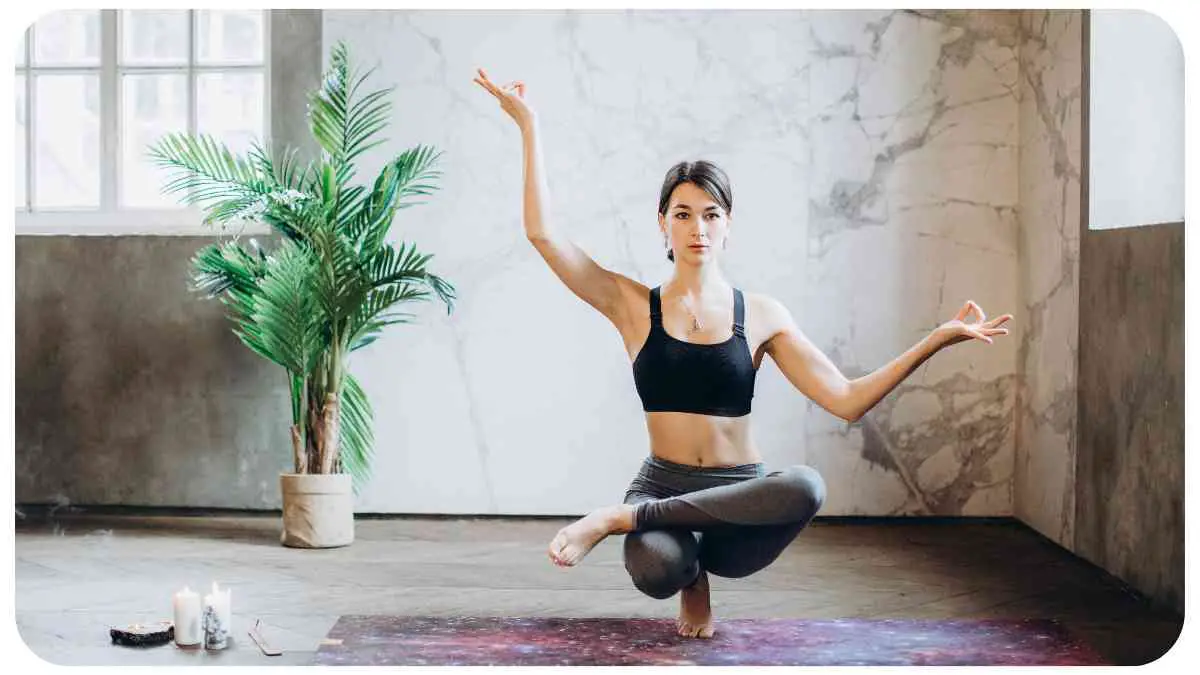Yoga is a holistic discipline that combines physical postures, breath control, meditation, and philosophical principles to promote wellness and self-awareness. While the benefits of yoga are numerous, achieving them requires correct practice. Unfortunately, many practitioners make common mistakes that can hinder their progress and even lead to injuries.
In this article, we will explore the most common mistakes in yoga practice and provide practical solutions to fix them. By avoiding these pitfalls, you can improve your practice and experience the transformative power of yoga.
| Takeaway |
|---|
| Focus on proper alignment and posture |
| Listen to your body and avoid overexertion |
| Cultivate breath awareness throughout your practice |
| Develop mind-body integration |
| Modify poses to suit your individual needs |
| Debunk common misconceptions about yoga |
| Incorporate yoga props for support and versatility |
| Embrace the journey of self-discovery and growth in yoga |
Common Mistakes in Yoga Practice
Mistake 1: Incorrect Alignment and Posture
One of the most prevalent mistakes in yoga practice is incorrect alignment and posture. Misalignments can strain the body, limit the benefits of the poses, and increase the risk of injury.
For example, in standing poses, the feet should be grounded firmly, the hips squared, and the spine elongated. Poor alignment can result in undue strain on the knees, hips, or back. To fix this, work with a qualified yoga instructor who can guide you in proper alignment and suggest modifications for your body.
Table: Common Misalignments and Correct Alignment in Standing Poses
| Pose | Common Misalignments | Correct Alignment |
| Mountain Pose | Rounded shoulders and collapsed core | Shoulders down, chest open, and engaged core |
| Warrior II | Collapsed front knee and shoulders | Front knee directly over ankle, shoulders level |
| Triangle Pose | Square hips and leaning forward | Hips open to the side, torso aligned with legs |
| Tree Pose | Bent knee and uneven weight | Knee facing forward, weight evenly distributed |
Mistake 2: Overexertion and Straining

In the pursuit of progress, it’s common for practitioners to push themselves too hard and strain their bodies in the process. This can lead to muscle soreness, joint pain, and even serious injuries. It’s important to remember that yoga is not a competition, and progress should be gradual.
Listen to your body’s signals and respect your limits. If a pose feels too challenging or painful, ease off and modify it. Pushing beyond your capabilities can hinder progress rather than facilitate it.
Table: Signs of Overexertion and Recommendations
| Sign of Overexertion | Recommendations |
| Extreme muscle soreness | Take a rest day or practice gentle yoga. Apply heat or cold therapy, and gently stretch the affected muscles. |
| Joint pain or swelling | Consult a healthcare professional to rule out any serious injuries. Modify or avoid poses that exacerbate the pain, and focus on gentle movements that soothe the joints. |
| Feeling fatigued or dizzy | Take breaks during your practice to rest and hydrate. Avoid intense poses and focus on a more gentle and meditative practice. |
| Difficulty breathing | Ease off on challenging poses. Practice pranayama (breathing exercises) that promote relaxation and deepen your breath control. |
Mistake 3: Lack of Breath Awareness
Breathing is an essential component of yoga practice, yet many practitioners overlook its significance. Correct breath awareness can enhance your practice,
Building a strong connection between yoga and spirituality is essential for a meaningful practice. Explore our guide on Yoga and Spirituality to tap into the deeper meaning and unlock the full potential of your yoga journey.
How to Fix Mistakes and Improve Your Yoga Practice
Fix 1: Focus on Alignment and Posture
To fix the common mistake of incorrect alignment and posture, it is crucial to develop a keen sense of body awareness and pay attention to proper alignment. Working with a knowledgeable yoga instructor can provide guidance on how to align your body correctly in each pose. Additionally, using props like blocks, straps, and bolsters can assist in achieving optimal alignment and provide support where needed.
Table: Alignment Tips for Common Yoga Poses
| Pose | Alignment Tips |
| Downward Dog | Spread your fingers wide and press firmly into your palms. Engage your core and lengthen your spine. Maintain a straight line from your hands to your tailbone. |
| Warrior I | Square your hips to the front of the mat. Bend your front knee directly over your ankle. Lift your chest and relax your shoulders away from your ears. |
| Child’s Pose | Extend your arms forward, lower your hips onto your heels, and rest your forehead on the mat. Allow your shoulders to relax and breathe deeply into your back. |
| Bridge Pose | Press your feet firmly into the mat, engage your glutes and core, and lift your hips. Interlace your fingers beneath you and roll your shoulders back to open your chest. |
Fix 2: Listen to Your Body and Avoid Overexertion
Overexertion is a common mistake that can lead to injuries and hinder your progress in yoga. It is important to pay attention to how your body feels during your practice and avoid pushing yourself beyond your limits.
Instead of striving for perfection or competing with others, focus on practicing yoga at your own pace. Remember that each person’s capabilities are unique, and honoring your body’s needs will ultimately benefit your practice.
Table: Signs of Overexertion and Self-Care Recommendations
| Sign of Overexertion | Self-Care Recommendations |
| Extreme muscle soreness | Take a rest day or practice gentle yoga. Apply heat or cold therapy, and gently stretch the affected muscles. |
| Joint pain or swelling | Consult a healthcare professional to rule out any serious injuries. Modify or avoid poses that exacerbate the pain, and focus on gentle movements. |
| Feeling fatigued or dizzy | Take breaks during your practice to rest and hydrate. Avoid intense poses and focus on a more gentle and meditative practice. |
| Difficulty breathing | Ease off on challenging poses. Practice pranayama (breathing exercises) that promote relaxation and deepen your breath control. |
Fix 3: Cultivate Breath Awareness
Breath awareness is a fundamental aspect of yoga that can greatly enhance your practice. By focusing on your breath, you can cultivate a sense of calm, increase oxygen flow, and improve energy circulation within your body.
Incorporate deep, mindful breathing throughout your practice, syncing each breath with your movements. This will help you stay present, calm your mind, and deepen your mind-body connection.
Yoga not only benefits the physical body but also fosters spiritual growth by helping you connect with your higher self. Discover the spiritual benefits of yoga and experience a profound transformation on both physical and spiritual levels.
Fix 4: Develop Mind-Body Integration

Achieving mind-body integration is essential in yoga practice. It involves cultivating mental focus and being fully present in each pose and movement. By turning your attention inward and observing the sensations in your body, you can develop a deeper understanding of your practice.
To enhance mind-body integration, consider incorporating meditation or mindfulness exercises into your yoga routine. Additionally, practicing yoga with intention and being mindful of the purpose behind each pose can further deepen your connection and enhance the benefits of your practice.
Remember, yoga is a journey of self-discovery, and it is essential to approach your practice with patience, kindness, and self-compassion. Embrace the opportunity to learn from your mistakes, and use them as stepping stones to progress on your yoga journey.
Don’t let back pain hinder your yoga practice and well-being. Learn how to say goodbye to back pain with the help of effective yoga poses. Check out our guide on yoga poses for back pain to alleviate discomfort and improve your overall physical condition.
Finding Your Edge: Balancing Challenges and Limitations
As you progress in your yoga practice, it is important to find the balance between challenging yourself and respecting your limitations. Each individual has unique physical abilities and limitations, and it is crucial to honor and work with what is present within your body.
Understanding Your Physical Limitations
Recognizing and understanding your physical limitations is key to avoiding injuries and practicing yoga safely. Certain health conditions, previous injuries, or mobility restrictions may require modifications or adaptations in your practice.
Consulting with a healthcare professional or an experienced yoga instructor can provide valuable insights and guidance specific to your needs.
Pushing Yourself Without Overdoing It
While it is important to challenge yourself in yoga, it is equally important to avoid overdoing it or pushing beyond your limits. Pushing too hard can lead to burnout, fatigue, or even injury. Instead, try to find a balance between effort and ease in your practice. Listen to your body’s cues, respect your boundaries, and gradually
Modifying Poses for Individual Needs
In yoga, it’s essential to modify poses to suit your individual needs and limitations. Not every pose will be accessible or suitable for every body. Modifying poses allows you to experience the benefits of yoga while ensuring your practice remains safe and comfortable.
Table: Modifications for Common Yoga Poses
| Pose | Modifications |
| Downward Dog | Place your hands on blocks to reduce wrist strain. Bend your knees slightly to relieve tension in the hamstrings. |
| Warrior II | Shorten your stance or use a wall for support if balance is an issue. Keep your back heel lifted or use a block for stability. |
| Tree Pose | Place your foot below the knee instead of on the inner thigh for added stability. Use a wall or chair for support if needed. |
| Seated Forward Fold | Bend your knees or use a strap to reach for your feet. Sit on a folded blanket for extra support and comfort. |
By modifying poses according to your needs, you can adapt your yoga practice to accommodate limitations or injuries without sacrificing the benefits. Remember, yoga is a personal journey, and it’s more important to listen to your body than to push for perfection.
Common Misconceptions About Yoga
Before diving deeper into troubleshooting your yoga practice, let’s address some common misconceptions associated with yoga.
Misconception 1: Yoga is Just About Flexibility
While flexibility is one aspect of yoga, it is not the sole focus. Yoga encompasses a holistic approach to physical and mental well-being. It combines breath control, strength, balance, flexibility, and mindfulness. The practice of yoga aims to create harmony and unity within the body, mind, and spirit.
Yoga can be an effective tool for weight loss when combined with a mindful approach. Our comprehensive guide on Yoga for Weight Loss provides valuable insights, tips, and recommended practices to help you achieve your weight loss goals in a healthy and balanced way.
Misconception 2: You Have to Be Young and Fit to Practice Yoga
Yoga is for everyone, regardless of age, body type, or fitness level. It is a versatile practice that can be tailored to individual needs. Modifications and variations exist for every pose, allowing practitioners of all abilities to participate and benefit from yoga. Whether you’re a beginner or experienced, young or old, there is a yoga practice suitable for you.
Misconception 3: Yoga is Only for Women

Yoga is often associated with women, but it is an inclusive practice for people of all genders. Historically, yoga was practiced mostly by men. Today, yoga is gaining popularity among men, with many reaping the physical, mental, and emotional benefits it offers. Yoga transcends gender and welcomes all who seek its transformative effects.
Misconception 4: Yoga is a Religion
Yoga is not a religion but a spiritual and philosophical practice. Its roots can be traced back to ancient texts, such as the Yoga Sutras of Patanjali. While yoga incorporates elements of spirituality, such as mindfulness and the exploration of higher consciousness, it is a personal journey that can be practiced by individuals from any religious or spiritual background.
Yoga Props: Tools for Enhancing Practice
Yoga props are valuable tools that can assist and enhance your practice. They provide support, stability, and enable modifications to make poses more accessible. Let’s explore some commonly used yoga props:
Yoga Blocks
Yoga blocks are versatile foam or cork blocks used to support and modify poses. They can help bring the floor closer to you, making poses more accessible. Blocks can aid in finding proper alignment, provide stability, or serve as a support when flexibility is limited.
Yoga Straps
Yoga straps are long, sturdy belts used to extend your reach, especially in poses that require deep stretching. They can be helpful for people with limited flexibility or when working towards more advanced poses. Straps allow you to achieve proper alignment and maintain a comfortable stretch without straining.
Yoga Bolsters
Yoga bolsters are soft, cushion-like props used for support and relaxation during restorative and gentle yoga practices. They provide comfort and help release tension in the body, facilitating relaxation and deepening the benefits of the poses.
Yoga Blankets

Yoga blankets are versatile props that can be folded or rolled to provide support, cushioning, or warmth during practice. They can be used for seated poses, as knee padding, or as a bolster substitute. Yoga blankets are also useful for regulating body temperature during relaxation or meditation.
Integrating yoga props into your practice can enhance your experience by providing additional support, stability, and comfort. Props allow you to explore poses safely and make modifications that suit your individual needs.
Discover the scientific principles behind the practice of mindfulness and its impact on mental health. Gain a deeper understanding by exploring our comprehensive guide on the science of mindfulness to enhance your well-being and cultivate a more balanced and mindful life.
Conclusion
By recognizing and fixing common mistakes in your yoga practice, you can improve the quality of your experience and make progress towards your goals. Remember to focus on alignment, listen to your body, cultivate breath awareness, and develop mind-body integration. Finding the balance between challenge and limitation is crucial, and modifying poses to suit your individual needs ensures safety and comfort in your practice.
Additionally, it’s important to debunk common misconceptions about yoga, such as it being solely about flexibility, exclusive to certain demographics, or a religious practice. Yoga is a holistic discipline that embraces inclusivity and offers benefits for individuals of all backgrounds and abilities.
Incorporating yoga props, such as blocks, straps, bolsters, and blankets, can further enhance your practice by providing support, stability, and versatility. Select the props that suit your needs and explore how they can assist you in deepening your practice.
Remember, yoga is a lifelong journey of self-discovery and growth. Embrace the process, be kind to yourself, and celebrate each step forward on your path to well-being and self-awareness. Namaste!
Further Reading
Here are some additional resources to further explore common yoga mistakes and how to fix them:
- Yoga Basics: Common Yoga Mistakes: This article provides insights into common mistakes made by beginners in yoga and offers practical tips to correct them.
- Ekhart Yoga: 5 Common Mistakes in Yoga: Learn about five common mistakes in yoga practice and discover ways to overcome them for a more effective and enjoyable experience.
- Yoga Fever: 7 Common Yoga Mistakes & How to Fix Them: Explore seven common yoga mistakes and find solutions to correct them, improving your practice and avoiding potential injuries.
FAQs
What are some common mistakes in yoga?
Common mistakes in yoga include incorrect alignment and posture, overexertion, lack of breath awareness, and a lack of mind-body integration.
How can I fix incorrect alignment in yoga poses?
You can fix incorrect alignment by working with a knowledgeable yoga instructor, using props for support, and focusing on body awareness. Proper alignment ensures the poses are performed safely and effectively.
How do I avoid overexertion in my yoga practice?
To avoid overexertion, listen to your body and avoid pushing yourself beyond your limits. Practice at your own pace, respect your boundaries, and take breaks when needed. It’s important to balance effort with rest and recovery.
Why is breath awareness important in yoga?
Breath awareness is crucial in yoga as it helps create a sense of calm, improves oxygen flow, and enhances mind-body connection. It keeps you present, focused, and supports the flow of energy throughout your practice.
How can I develop mind-body integration in yoga?
To develop mind-body integration, turn your attention inward, observe the sensations in your body, and practice mindfulness. Meditation and intention-setting can also aid in deepening your mind-body connection.

Hello, my name is Hellen James! I am a yoga teacher and writer who loves to share information about how you can achieve a more fulfilling life. I have been practicing mindfulness, yoga, and meditation for over 10 years. My passion for these practices has led me to teach them to others.

